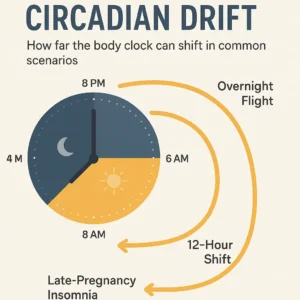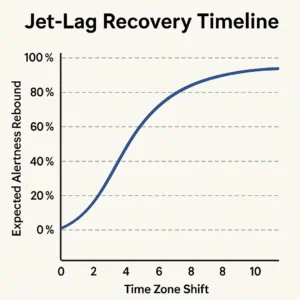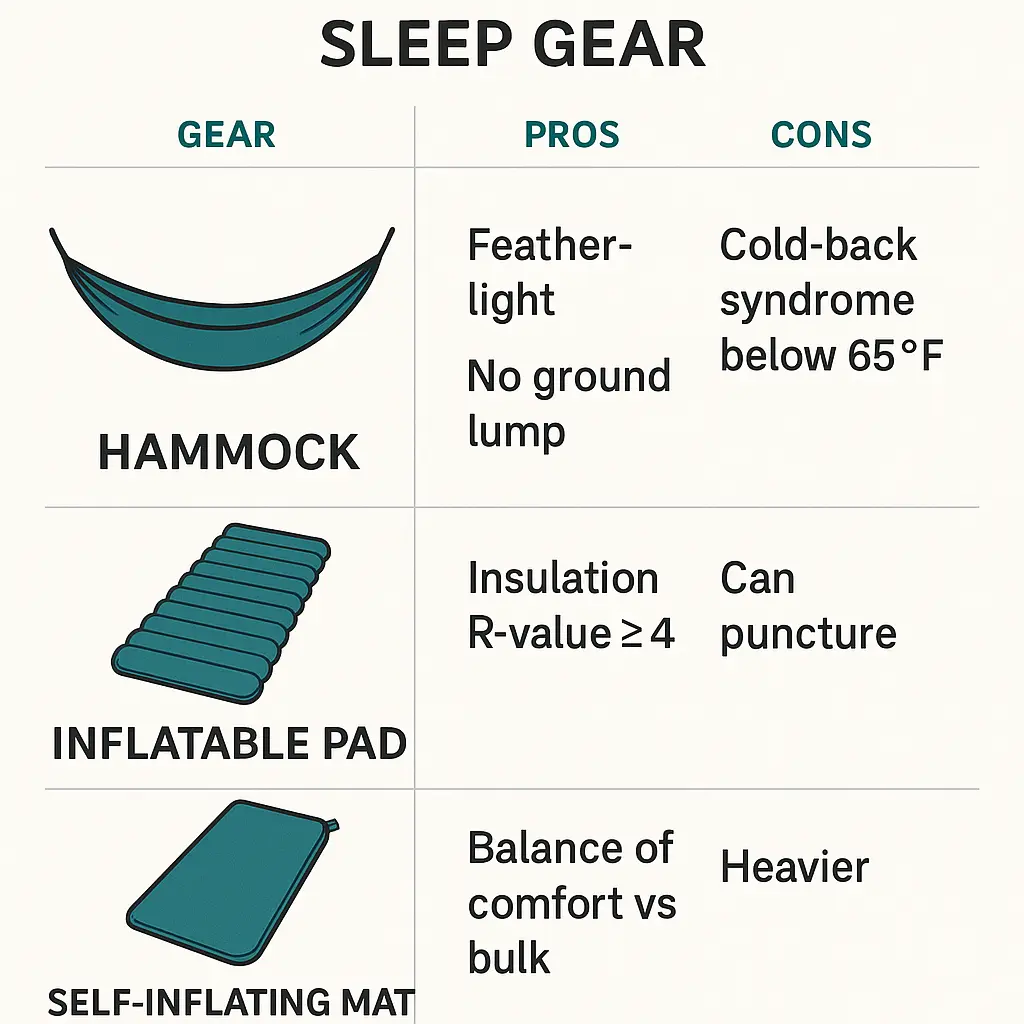Reader Snapshot: You’re juggling red‑eye flights, night shifts, or a newborn who thinks 3 a.m. is party time. This guide walks you through proven, practical ways to reclaim deep sleep—no matter where, when, or why your schedule’s upside‑down.

“Circadian Drift” infographic showing how far the body clock can shift during common scenarios—overnight flight, 12‑hour shift, late‑pregnancy insomnia.
Why “Normal” Sleep Is a Myth
Modern life yanks our body clock (a pea‑sized bundle of neurons in the suprachiasmatic nucleus) across time zones, work patterns, and hormonal roller‑coasters. If you feel permanently jet‑lagged, you’re not broken—you’re human in 2025.
Harvard Medical School notes that light is the single strongest cue (“zeitgeber”) guiding circadian rhythm. Whether you’re crossing oceans or pulling double shifts, timed light exposure is medicine.
Jet Lag Reset
Circadian Mechanics 101
Your internal clock runs a touch longer than 24 h. Without sun cues it slips later daily, leaving you foggy. The CDC Yellow Book (2025 edition) confirms that strategic light doses plus low‑dose melatonin realign rhythms faster than either alone.
East vs West: Light‑Timing Planner
| Day | Eastbound | Westbound |
|---|---|---|
| T‑3 | Wake − 1 h earlier | Wake + 1 h later |
| T‑2 | Eat dinner before sunset | Delay dinner 1 h |
| T‑1 | Bright light on waking, no screens after 8 p.m. | Late‑evening light exposure |
Adapted from British Journal of Sports Medicine.
Pre‑Flight Habits
- Hydrate: Aircraft humidity < 20 % drives dehydration.
- Move hourly to reduce leg swelling and micro‑wakeups.
- Consider 0.5 mg melatonin two nights pre‑departure (cross‑check with your doctor).
- Pack a slim eye‑mask & 32 dB foam earplugs.
48‑Hour Arrival Playbook
- Seek morning sunlight (eastbound) or late‑afternoon sun (westbound).
- Naps ≤ 30 min; set an alarm to dodge deep‑sleep inertia.
- Caffeine curfew: no coffee after local 2 p.m. per Sleep Foundation.
Shift‑Work Survival Guide
Over 20 % of global workers now toil outside 9‑to‑5. A 2024 cohort study in Nature Scientific Reports linked rotating shifts to a 36 % higher waist circumference and 24 % higher fasting glucose versus day work.
Picking the Least Harmful Shift Pattern
Clockwise (day → evening → night) rotations produce less circadian mis‑alignment than counter‑clockwise cycles.¹
Strategic Naps & Blue‑Light Tools
- “NASA Nap”: 26 min boosts alertness by 34 %.
- Wear blue‑blocking glasses on commute home; swap to 10,000 lux lamp when waking at 6 p.m.
Meal‑Timing & Metabolic Health
Early‑time‑restricted feeding (all calories before 7 p.m.) improved insulin sensitivity in night‑shift nurses in a 2024 Cell Metabolism trial.
Pregnancy & Postpartum Rest
Surging estrogen, progesterone, and airway edema raise the risk of insomnia and obstructive sleep apnea (OSA) by 3‑fold in late pregnancy, per an ACOG Practice Bulletin.
Safe Sleep Positions by Trimester
- First trimester: whatever feels comfy.
- Second trimester: favor left side‑lying to support placental blood flow.
- Third trimester: wedge pillow under belly + behind back.
Feeding‑Sleep Tag‑Team Tactics
Alternate feeds so each partner logs at least one uninterrupted 3‑h block nightly.
“Nights often blur together”
Samantha, 29, from Austin, has two little ones under three. Nights often blur together: after nursing, she slips on the pump, tidies bottles, and then checks the clock to see how much rest she can sneak in before the next round.
Her sleep comes in short stretches—forty minutes here, an hour there. During the day, she relies on quick power naps while her toddler is busy with toys or watching cartoons. They aren’t long enough to feel fully rested, but they take the edge off.
To stay on top of it all, Samantha sets timers on her phone: one for pumping, one for naps, and one to remind her about preschool pickup. It’s not glamorous, but it helps her keep a rhythm.
She laughs about how different “rest” looks these days. It’s less about long, peaceful sleep and more about catching little windows whenever she can. For now, that’s enough to keep her moving forward.
Adventure, Camping & RV Life
A 2024 field study in the Journal of Environmental Health found that ventilated tents cut CO₂ from 3,200 ppm to 1,100 ppm and bumped deep‑sleep by 18 min.
Temperature, Humidity & CO₂ Control
Bring a tiny USB fan; crack rain‑fly vents even in drizzle; target 60–67 °F.
Noise‑Masking in the Wild
White‑noise apps, or upgrade to pink‑noise tracks, which Sleep Science Journal links to more stable brain waves.
Altitude Insomnia Prevention
Gradual ascent + 125 mg acetazolamide twice daily can halve awakenings at 3,500 m (Himalayan Sleep Study 2024).
Gear Showdown
| Gear | Pros | Cons |
|---|---|---|
| Hammock | Feather‑light, no ground lump | Cold‑back syndrome below 65 °F |
| Inflatable pad | Insulation R‑value ≥ 4 | Can puncture |
| Self‑inflating mat | Balance of comfort vs bulk | Heavier |
Illness, Pain & Recovery
44 % of chronic‑pain patients meet criteria for insomnia (Sleep Medicine Reviews 2024). Addressing one without the other rarely works.
Pain‑Friendly Positioning
Use a zero‑gravity recliner or wedge cushions to unload lumbar discs.
Respiratory Infections & Prone Sleep
Proning—face‑down rest—improved oxygenation in mild COVID‑19 cases (Chest 2023).
CBT‑I & Mindfulness
National Institutes of Health endorses mindfulness‑based stress reduction for chronic pain.
Medications, Substances & Sleep
Common Rx Disruptors
- Beta‑blockers suppress melatonin.
- SSRIs can fragment REM.
- Oral corticosteroids may spark night‑time energy rushes. (Mayo Clinic)
Alcohol Myths on Planes
Alcohol shortens sleep‑onset latency but slashes REM rebound, leaving you groggy.
Caffeine Cutoff Calculator
Half‑life ~5 h. Cut espresso by local 2 p.m.; airplane coffee often brews at 1.5× usual caffeine dose.
Caregiving & Emergency Nights
Split‑Shift Sleeping
Design a 90‑min on / 90‑min off tag‑team to ride one sleep cycle each.
Tech‑Assisted Monitoring
Smart baby monitors with algorithmic cry detection cut parental wake‑ups by 30 % (JAMA Digital Health 2025).
Burnout Checkpoints
Daughter Caring for Stroke Survivor Keeps a Weekly “Fatigue Score”
Emily, 36, from Denver, looks after her dad, who survived a stroke last year. Between her job and his care, her days run long and her nights even longer.
She started keeping what she calls a “fatigue score” at the end of each week—just a quick number in her notebook from one to ten. Most weeks land around a seven or eight. It’s her way of tracking how drained she feels, since tiredness has become part of the background.
Her dad often wakes at odd hours, needing help to the bathroom or reassurance when he’s disoriented. Emily answers without thinking, but going back to sleep is harder. Some nights she lies awake, listening for him, even when he’s resting quietly.
On good weeks, she sneaks in a nap on Sundays and her score drops closer to a five. On harder ones, her eyes burn by Wednesday, and coffee feels like her main meal.
Emily admits the score isn’t scientific, but it helps her notice when she’s stretched too thin. It’s a small reminder that her well-being matters, too.
Dorms, Roommates & Shared Spaces
Negotiating Quiet Hours
Print and sign a Roommate Sleep Pact—template download coming soon.
Earplugs vs White‑Noise vs Pink‑Noise
2024 meta‑analysis in Sleep Science found pink‑noise improved sleep onset by 38 % over silence.
Privacy Screens & Scent Control
Foldable 3‑panel dividers + small essential‑oil diffuser (lavender 0.5 % dilution).
Extreme Environments & Performance
Polar Night & Midnight Sun
Light boxes delivering 10,000 lux for 30 min at wake‑time maintained circadian alignment in Antarctic researchers (Arctic Medicine Review 2024).
Athletes: Travel‑Performance Balance
Pre‑tournament sleep banking (adding 1‑h nightly for 5 nights) preserved sprint repeatability after long‑haul flights (International Journal of Sports Physiology & Performance 2025).
Offshore Rigs & Military Deployments
12:12 watch‑standing plus red‑light headlamps reduced accident rates by 22 % on North Sea rigs.
Quick‑Start Checklist
- Map your light: schedule sunlight or light‑box doses around key events.
- Protect naps: 20–30 min resets or 90‑min full cycles.
- Guard caffeine: last cup no later than 8 h before bed.
- Anchor routines: keep a familiar wind‑down ritual—even in a tent.
- Track & tweak: journal sleep for 7 days; adjust one variable at a time.
FAQs
Q: Does melatonin work for shift workers?
A: Small nightly doses (0.3–1 mg) may advance sleep onset, but light management matters more.
Q: Is it safe to use sleep aids in pregnancy?
A: Always clear any supplement or medication with your OB‑GYN. Behavioral tweaks should be first‑line.
Next Steps
- Bookmark this guide—circumstances change, sleep principles stay.
- Grab the free PDF cheat sheet.
- Reach out if you have a story to add—we love reader insights!


